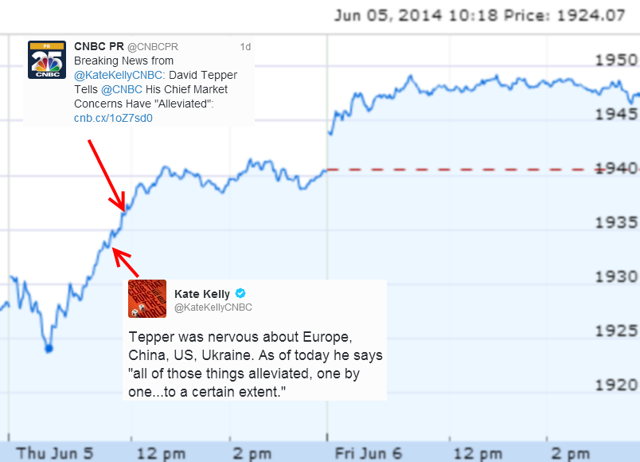 This was a week with some potentially market rattling news.
This was a week with some potentially market rattling news.
Whenever the market is sitting at new highs, especially when having done so in a series of tentative moves and on low volume the risk may be heightened for a reversal of fortunes.
For definitional purposes, I would call that “exciting.”
Among the potential stumbling blocks to further market records were the much awaited announcement by Mario Draghi, the President of the European Central Bank, regarding interest rates, followed the next day by the monthly Employment Situation Report.
However, both were expected to be devoid of surprise and weren’t widely expected to move the markets unless some true surprise was announced.
True to expectations neither event contained any surprises.
In contra-distinction, I would call that boring and would generally expect ambivalence in response. Yet despite fully expecting the outcomes the market added nearly 100 points on each of those days, turning those yawns of boredom into gains and giving meaning to the age old saying that “no news is good news.”
The ECB’s reduction of its key lending rate was taken in stride and was a non-event, yet for some reason the market closed with just shy of a triple digit gain having suddenly turned around from an early morning loss. That early loss seemed more in line with another age old saying that has us selling on the news.
As the gain picked up some steam there was an obligatory need to find a reason and it was simple, as David Tepper, hedge fund manager and founder of Appaloosa Management, who had recently moved markets both up and down, was reported by CNBC’s Kate Kelly, via CNBC’s Twitter publicity machine to have said that his market concerns had “alleviated.”
That revelation soon found its way into what now passes for mainstream media and was reported as “David Tepper Isn’t Nervous Anymore.”
click to enlarge)
It’s always nice to know what’s going on and what causes market moves. Of course, what was conveniently missing here was the time line, as the turnaround started at 10:18 AM and the initial Kelley Tweet didn’t appear until an hour later, at which point 50% of the gain in the S&P had already been realized.
By the time the CNBC publicity machine Tweet was posted and the Business Insider article appeared about 90% of the gain had already been realized.
But we can still give Tepper the credit. After all, it doesn’t really matter other than for the creation of image.
Friday was a little more straightforward. Completely expected non-farm payroll numbers and the market opened with a gap higher and just stayed there throughout the day. There was no need to look for search high and low for an explanation and make it fit the events.
The spin surrounding the employment statistics was that as a nation we were now back to pre-recession employment numbers, as if that itself would be received as meaningful or even good news.
The message seems to be that the market doesn’t need a catalyst to go higher. It just needs to ensure that there’s no deterrent. The status quo is just fine.
Boredom is the new black bottom line for portfolios.
As usual, the week’s potential stock selections are classified as being in Traditional, Double Dip Dividend, Momentum or “PEE” categories.
While boring may be good for your health and your portfolio Cree (CREE) the maker of LED light bulbs has been anything but boring since becoming a publicly traded company and is, nonetheless, high on my list for consideration this week.
That’s because Cree may be settling into senescence of late. After a disastrous response to its most recent earnings report it has settled into a downright boring trading pattern and its own measure of volatility is no longer one that should send a sane investor heading in a different direction.
While the recent trading pattern has been in a tight range, memories of days past that included numerous sharp rises and declines help to keep option premiums at attractive levels. In the past I’ve both owned shares and sold calls, as well as sold put contracts. Most recently, after some rollovers following an adverse price move, I accepted assignment and again own shares. This time around I may again elect the put sale route with the hope of being able to rollover contracts if assignment is likely.
Las Vegas Sands (LVS), on the other hand, may not be settling into senescence. Although its Chairman is getting on in years, he hasn’t let that dim his level of enthusiasm for life or diminish Las Vegas Sands’ impact on gaming worldwide.
While Caesers (CZR) cast a little pall on the sector on Friday with word of a notice of default from some bond holders, it was already a challenging week for casinos and Las Vegas Sands hasn’t been immune to the selling pressure.
Down about 15% from its March 2014 high I have been waiting for an entry point. Like Cree, I may prefer to do that with the sale of put options, although I may be more inclined to accept assignment, rather than rolling over, as shares go ex-dividend the following week.
One last bit of excitement may come from LuLuLemon Athletica (LULU) which reports earnings this week. Since I already own shares at a price far higher than it currently
sits, despite Friday’s 4% move higher and also am short puts, I’m considering the put sale route again this coming week.
Always a candidate for an explosive price movement on earnings and forward guidance, the options market is implying a 10.3% movement in price upon the event, which would suggest a lower price range of $40. However, a 1% weekly ROI may be able to be attained at a strike price as low as $38.50, which would represent a 13.8% price decline.
Could that large of a drop happen? With LuLuLemon? Absolutely. Just look at June 2013 or December 2013 earnings.
On the other hand, there is Lorillard (LO). The tobacco industry is generally a fairly boring one when litigation isn’t part of the equation. Lately the excitement level has gone a bit higher with the introduction of “e-cigarettes” of which Lorillard is said to be a leader.
But the real excitement revolves around the market’s response to the potential buyout of Lorillard, the tangled web of ownership and the potentially internecine relationships both between the various involved companies and with their own customers.
While there is always risk associated with jumping on board in anticipation of a buyout or merger, there’s little reason to believe that some kind of alliance won’t be realized, as there haven’t been any signs of protest or contention from any of the parties and there appears to also be a buy-in from British American Tobacco (BTI), which owns a substantial piece of the proposed acquiring company, Reynolds American (RAI). In addition to an attractive premium that was generally the case prior to buyout speculation, the longer the process is drawn out the more likely one is to also benefit from a very attractive dividend, as well.
The Gap (GPS) is an anachronism, as it remains one of the few retailers to still provide monthly comparable sales statistics.
In hindsight, it seems that I’ve been caught too often in the crossfire between those reports and the market’s reaction to those reports. I’ve also been trading in The Gap long enough to see that those reports vary wildly from month to month as does the subsequent reaction.
This past Friday was one such report and unusually, the comparable sales statistics were flat, as was the response. My existing shares were subsequently assigned. However, with any weakness in price, particularly returning shares to the $41 level, I would be an eager buyer, but would always try to be mindful of the recurring monthly event that makes the option premiums appear very attractive, but that bring along additional risk.
Finally, I’ve been lately focusing more on dividend payments, as option premiums increasingly reflect the low volatility environment. The combination of dividends and option premiums can address the challenge of low expectations for sudden price movements, particularly among “Traditional” or low beta stocks in an already low volatility market environment.
This week both Coca Cola (KO) and Merck (MRK) are ex-dividend. Neither are frequent targets for past purchase, although I have owned Merck twice in the past year and Coca Cola has been in one of my children’s accounts for more than a decade.
While there are some more adventurous and less boring potential positions to be considered this week, the boring DJIA components have a certain comfort level that may be just right at this point of the market’s climb.
One contrast to that boring approach to the accumulation of dividends is Newmont Mining (NEM) which is also ex-dividend this week. While suggestions that its dividend may be imperiled have slowed down, it is certainly tied to the price of gold, which has been imperiled on its own of late.
Already owning two more expensively lots of Newmont Mining and long suffering while awaiting some rebound in price, I’m finally ready to add shares in anticipation of an opportunity to realize some capital gains in addition to option premiums and dividends.
At that point I would then be happy to settle into boring mode.
Traditional Stocks: Lorillard, The Gap
Momentum: Cree, Las Vegas Sands
Double Dip Dividend: Coca Cola (6/12), Merck (6/12), Newmont Mining (6/10)
Premiums Enhanced by Earnings: LuLuLemon Athletica (6/12 AM)
Remember, these are just guidelines for the coming week. The above selections may become actionable, most often coupling a share purchase with call option sales or the sale of covered put contracts, in adjustment to and consideration of market movements. The overriding objective is to create a healthy income stream for the week with reduction of trading risk.
Views: 21




 Some weeks seem more productive than others.
Some weeks seem more productive than others.

 I really didn’t see this past week coming at all.
I really didn’t see this past week coming at all.




You must be logged in to post a comment.